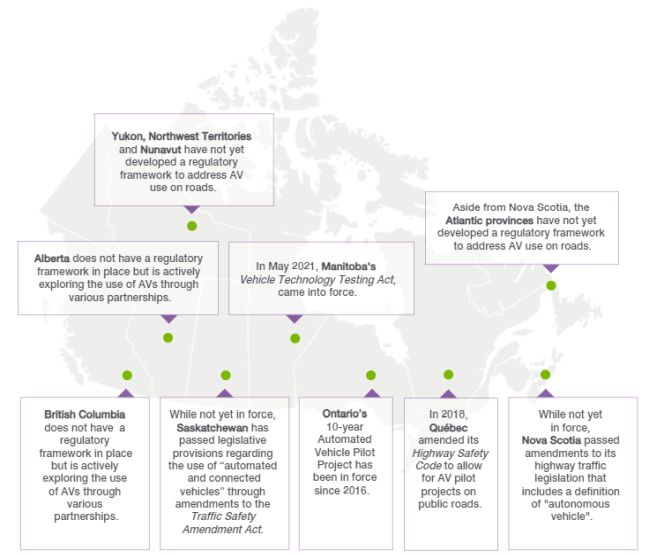The deployment of autonomous vehicles (AVs) in Canada poses a unique regulatory challenge given the country's legal landscape. All levels of government contribute to how this technology will be implemented on Canadian roads. In particular, each province and territory is responsible for its own autonomous vehicle laws and regulations regarding the safe operation of AVs. Provincial and territorial responsibilities include creating laws that govern vehicle registration, licensing and insurance.
In this article, we provide an overview of Canada's provincial and territorial landscape and review how each jurisdiction tackles the development, testing and deployment of AVs.
Alberta and British Columbia
British Columbia and Alberta have not introduced regulatory frameworks specific to AVs. Numerous pilot programs and government funding have been aimed at universities and related research in each province, but this has not translated into regulations. British Columbia's government has noted the need to adjust and adapt to emerging technologies in order to improve road safety and enhance mobility, while Alberta is currently exploring AV technology.
In November 2021, Alberta began testing the technique of truck platooning on the highway between Edmonton and Calgary.
The research on platooning uses driver assist technology in an effort to reduce drag and increase fuel efficiency. Edmonton is home to the ACTIVE-AURORA test bed, a collaborative effort by the Government of Canada, the Government of Alberta, the City of Edmonton, the University of Alberta's Centre for Smart Transportation (CST), and the University of British Columbia.
As AVs become more prevalent on Canada's roads, it is likely that Alberta and British Columbia will enact legislation to regulate AVs within their respective jurisdictions.
Saskatchewan
Saskatchewan has tabled and passed legislative provisions regarding the use of "automated and connected vehicles" through amendments to the Traffic Safety Amendment Act. While this act has received royal assent, the provisions related to the use of AVs are not yet in force. When they come into force, these amendments appear to be intended to create a regulatory framework to give the provincial administrator the authority to issue vehicle permits for the operation of AVs or "connected" vehicles, with the terms and conditions of operation defined within each permit.
Of note, these amendments require that drivers be in the driver's seat and at the controls of the AV, which would preclude level 5 automation (fully automated) where the vehicle does not contain any driver controls.
Further, to minimize the mischief that can occur with automated technology, Saskatchewan's amendments contain broad provisions intended to prevent interference or obstruction of AVs by third parties.
Manitoba
Manitoba recently made legislative changes to encourage and further develop the use of AVs within its jurisdiction. The Vehicle Technology Testing Act is in force after receiving royal assent in May 2021. This piece of omnibus legislation contains amendments to Manitoba's Highway Traffic Act, Insurance Act and Manitoba Public Insurance Corporation Act, which lay the groundwork for the adoption of AVs in Manitoba.
The Vehicle Technology Testing Act indicates that the Minister may issue a permit allowing a "test vehicle" to be driven with or without an automatic driving system engaged. The legislation also creates carve outs and exemptions for AVs that would otherwise contravene highway law requirements found in the respective acts and regulations. In addition, the legislation specifically exempts AVs from obligatory insurance requirement for drivers of a test vehicle if a technology-testing permit has been issued. However, Manitoba Public Insurance may recover the costs of property damage and personal injury against the holder of a technology-testing permit if the driver of the test vehicle is responsible for the accident.
Ontario
In 2016, Ontario became Canada's first jurisdiction to
introduce a regulatory scheme of regulating AVs through its 10-year Pilot Project -
Automated Vehicles regulation. Ontario's regulation
contains extensive guidance on AV use and tasks, while also
providing clarity by defining what constitutes an "advanced
driver assistance system" or a "dynamic driving
task." In 2019, Ontario introduced important amendments to its
pilot project regulatory framework. As part of these amendments,
the province moved to open the way to public use of level 3 AVs and
permit driverless testing of levels 4 and 5 AVs, along with
co-operative truck platooning. We previously provided a summary of
these key amendments in our article, "Ontario expands its automated vehicles regulatory
framework". Notably, Ontario's regulation imposes
certain obligations regarding reports and records on the owner to
whom an approval is issued with respect to testing under the
regulations. As well, under the regulation, there is broad
ministerial discretion to obtain reports and records as to the use
of AVs under the regulation. Unless specifically exempted in the
regulation, Highway Traffic Act rules of the
road and penalties apply to the operation of AVs on public roads in
Ontario.
On September 29, 2021, Ontario announced that it is considering key
amendments to its current regulatory framework, including potential
amendments to the Manufacturer Plate Program. Notably, the proposal also
includes amendments to permit the testing of automated
farm vehicles and micro-utility devices. We therefore expect
further developments in 2022 and beyond of Ontario's current
regulatory framework to facilitate the continued testing and
deployment of AVs.
Québec
In 2018, Québec amended legislation that authorized the implementation of pilot projects for AVs for levels 3, 4, and 5. We previously summarized the Québec regulatory framework in our article "Québec moves forward with regulation of autonomous vehicles". The Québec legal framework allows for pilot projects and the authority to grant an exemption from insurance contributions. The Minister sets the rules and conditions for the implementation of any pilot project, and authorizes any person or body to use a vehicle in compliance with the standards and rules they prescribe. Pilot projects are conducted for three to five years and allow for cancellation or extension at the Minister's determination. Under the Québec pilot regulatory framework, two key pilot projects were deployed, including what was hailed as Canada's first self-driving electric shuttle. We previously provided summary highlights of these two pilots in our article, "Driverless vehicles: Two years of autonomy on Québec roads".
Nova Scotia
While it has not yet received royal assent, Nova Scotia has passed amendments to its highway traffic legislation that defines both "autonomous vehicle" and "autonomous mode," allowing flexibility for the regulations to adapt to different technologies and Society of Automotive Engineers (SAE) levels, as vehicles and features are made available to consumers.
The legislation leaves open the possibility for regulations to group different features or vehicles in order to provide guidance on what is and what is not autonomous. It also mandates that the driver of the vehicle "must be able to personally drive the vehicle," regardless of whether it is autonomous or uses an autonomous feature. Notably, "distracted driving" does not carve out a provision for autonomous modes – meaning a driver can be distracted even when a vehicle is driving autonomously.
Nova Scotia's legislative approach specifically allows the minister to prescribe insurance requirements related to AVs.
New Brunswick, Prince Edward Island, and Newfoundland and Labrador
Beyond traditional road use, insurance and vehicle legislation, these provinces have not yet developed a regulatory framework to specifically address testing and deployment of AVs. As AVs become more commonplace, like Alberta and B.C., it is likely that these East Coast provinces will enact legislation to regulate testing and use of AVs.
Yukon, Northwest Territories and Nunavut
Canada's territories do not currently have a regulatory framework in place to address AV use on roads.
Territories may chose to pursue trial or pilot programs and may set up authorization procedures for the use of AVs within their jurisdiction. Given the unique and challenging driving conditions in Canada's territories, they likely offer an ideal testing platform for AV manufacturers to obtain valuable data on AV effectiveness in extreme cold weather environments.
Moving forward

The provincial and territorial approach to regulating AVs is in its early stages, involving mostly pilot projects and amendments to existing legislation. With significant guidance available both nationally and internationally, we expect that 2022 will bring developments to the creation of regulatory roadmaps for each province in preparation for the deployment of AVs.
The content of this article is intended to provide a general guide to the subject matter. Specialist advice should be sought about your specific circumstances.



